Test geek and founder of Aptitude-Test-Prep.com
What Is the EEI TECH Test?
The EEI TECH Test (Technician Occupations Selection System) is a pre-employment assessment battery used to screen candidates for electric utility industry technical occupations. The test is designed and administered by the Edison Electric Institute (EEI).
The EEI TECH measures 4 cognitive abilities designed to predict candidates’ performance.
Test Structure and Question Format
The EEI TECH Test is divided into 4 sections, each with its own content and time limit:
- Graphic Problem Solving – 16 questions in 15 minutes.
- Interpreting Diagrams – 16 questions in 15 minutes.
- Mechanical Concepts – 44 questions in 20 minutes.
- Reasoning from Rules – 15 questions in 15 minutes.
Let’s describe each of these sections in a bit more detail.
You will find detailed answers for the questions below (+more) in the Free Practice section. You can also find additional info and prep resources on JobTestPrep’s EEI TECH page.
Full Disclosure: We are affiliated with JobTestPrep. Clicking the links helps us providing you with high-quality, ad-free content.
Graphic Problem Solving
The Graphic Problem Solving section measures your ability to extract numerical data from illustrations and perform calculations based on it. This section contains 16 questions to be solved in 15 minutes. The section is very similar to the Graphic Arithmetic section on the CAST test.
Half of the questions on this section will deal with a technical drawing, and the other half will deal with a graph.
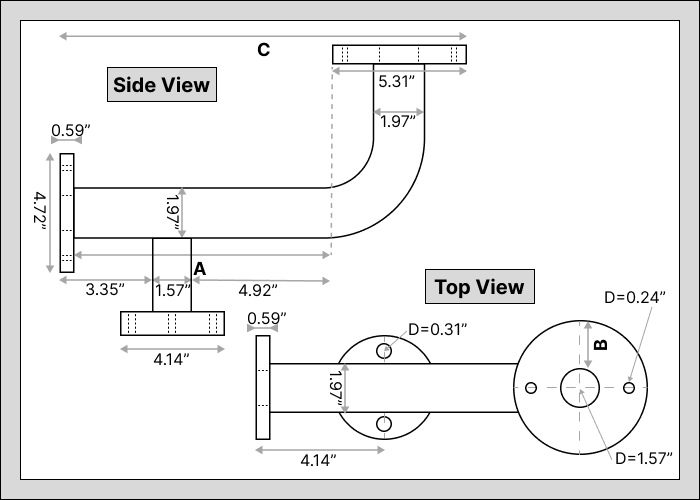
Interpreting Diagrams
The Interpreting Diagrams section assesses your ability to quickly and correctly locate items on maps and diagrams. You have 15 minutes to solve 16 questions.

Mechanical Concepts
The questions in the Mechanical Concepts section assess your understanding of basic mechanics and electricity. The questions do not require calculations, and therefore can be solved quickly. The section contains 44 questions to be solved in 20 minutes.

Pro Tip
The variety of questions in the Mechanical Concepts section requires you to understand the major physical principles at the heart of the test. Examples are law of the lever, centrifugal force, fluid mechanics, etc. We recommend JobTestPrep’s EEI TECH prep course, which contains a wide variety of mechanical practice questions.
Reasoning from Rules
The Reasoning from Rules section assesses your ability to understand and apply logical rules from a text or a diagram. The section contains 15 questions to be solved in 15 minutes. Half of the questions on the section will deal with a text, and the other half will deal with a diagram (e.g. a flow chart).
Check out the Free Practice section to try these questions yourself, and more.
Test Interface
The TECH test interface is very understandable and straightforward. That is similar to other EEI tests like CAST, MASS, or POSS. However, there are some things to know about the test, and what you should do about it.
Separate Sections
Each of the 4 sections on the EEI TECH Test has its own time limit and is given as a separate test. As such, you will not be able to allocate spare time from other sections and must be well-prepped for each section’s specific time constraints.
You Can Move Between Questions
During the test, you will be able to move back and forth between questions or skip them and get back to them later. That allows you to manage your time better and keep the more challenging questions to the end, since every question gets the same score.
No Points Reduced for Wrong Answers
Your score on the TECH Test will be determined based on the number of correct answers. Therefore, guessing is better than leaving questions unanswered.
Calculators Are Not Allowed
Calculations are not a major topic in the TECH test, but they will be required. You are expected to be able to make these calculations without the help of a calculator. Consider that fact while practicing, and make sure you have mastered quick and accurate pen-and-paper calculation methods.
Free Practice
This free practice test includes 15 questions, and is designed to get you familiar with the types of questions on the EEI TECH Test and their level of difficulty.
You will also find answers, explanations, and tips for success. For more sample questions, you may also check JobTestPrep’s EEI TECH webpage.
Good luck!
Section 1 – Graphic Problem Solving
Question 1
Refer to this drawing for questions 1-3.

What is the distance between the left circular connection and the top circular connection (A)?
- 10.05”
- 12.41”
- 9.84”
- 9.25”
Answer and Explanation
The correct answer is D – 9.25”.
3.35” + 1.57” + 4.92” – 0.59” = 9.25”

Question 2
What is the distance between the edge of the top circle and the edge of the middle hole (B)?
- 3.34”
- 1.87”
- 3.74”
- 1.67”
Answer and Explanation
The correct answer is B – 1.87”.
[(5.31” – 1.57”) / 2] = 1.87”

Question 3
What is the overall length of the device (C)?
- 15.15”
- 15.74”
- 16.02”
- 16.46”
Answer and Explanation
The correct answer is A – 15.15”.
3.35” + 1.57” + 4.92” + 5.31” = 15.15”
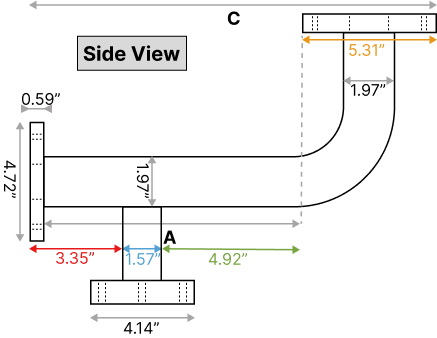
Refer to this graph for questions 4-5.
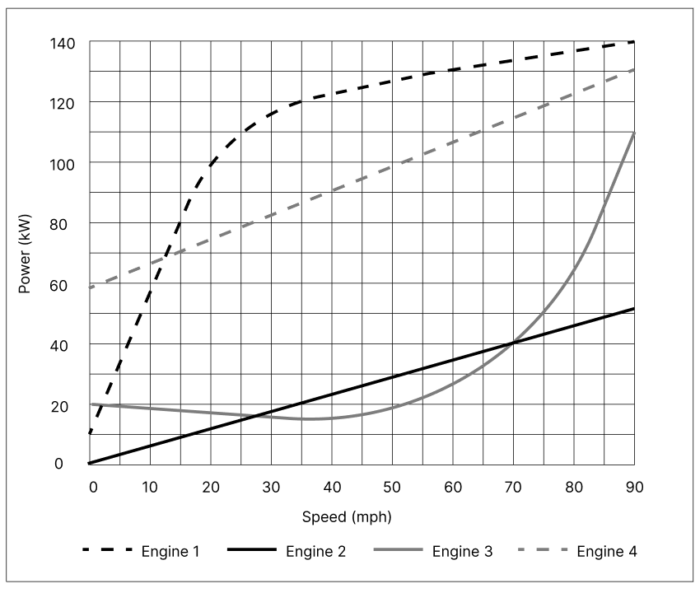
Question 4
What is the power of Engine 4 at 40 mph?
- 15 kW
- 60 kW
- 90 kW
- 125 kW
Answer and Explanation
The correct answer is C.

Question 5
For what power, approximately, do Engine 2 and Engine 3 generate the same speed?
- 17 kW
- 70 kW
- 40 kW
- A and C
Answer and Explanation
The correct answer is D.
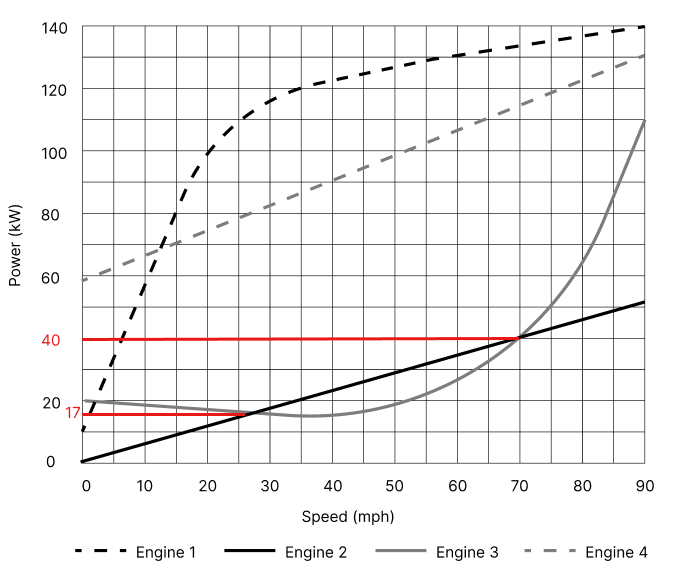
Section 2 – Interpreting Diagrams
Refer to this diagram for questions 6-9.
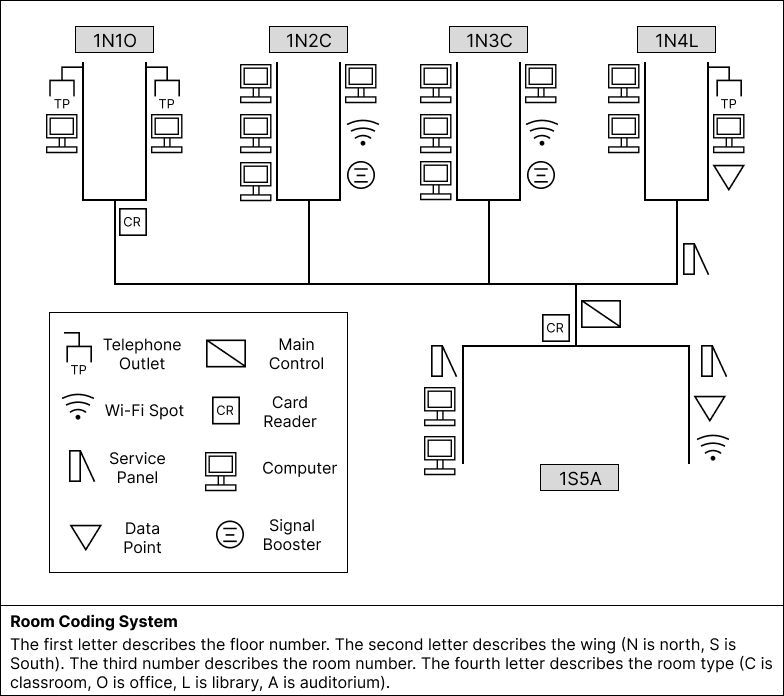
Question 6
Which floor is shown in the plan?
- Floor 1
- Floor 2
- Floor 3
- More than one floor
Answer and Explanation
The correct answer is A.
The first number in the coding system describes the floor number. Since all room codes in the plan begin with 1, the plan describes floor 1.
Question 7
What room type/s do not require a card to enter?
- Classroom
- Classroom and Library
- Classroom, Library, and Auditorium
- Office and Library
Answer and Explanation
The correct answer is B.
Card readers are located in the entrances to the auditorium (1S5A) and the office (1N1O). They are not located in the classrooms (1N2C and 1N3C) and the library (1N4L).
Question 8
All computers in rooms that contain a Wi-Fi spot need to have their software upgraded. How many computers will be upgraded?
- 8
- 9
- 10
- 12
Answer and Explanation
The correct answer is C.
There are 10 computers in rooms that have a Wi-Fi spot:
- Classroom 2 (1N2C) – 4 computers.
- Classroom 3 (1N3C) – 4 computers.
- Auditorium (1S5A) – 2 computers.
Question 9
The new telecom standard requires a data point to be installed in any room with more than 2 computers. How many additional data points should be installed?
- None
- 1
- 2
- 3
Answer and Explanation
The correct answer is C.
There are 3 rooms with more than 2 computers – the classrooms (1N2C, 1N3C) and the library (1N4L). However, since the library already has a data point, only 2 additional data points need to be installed.
Section 3 – Mechanical Concepts
Question 10

Answer and Explanation
The correct answer is B.
In a pipe where the flow is uniform, the narrower the pipe, the faster the flow. The underlying physical principle is the volumetric flow rate formula.
Q = V x A
- Q = volumetric flow rate
- V = flow velocity
- A = pipe cross-section area
Since Q is constant along the entire pipe, if A is lower, V must be higher.
Pro Tip
While the mechanical concepts section does not require previous knowledge, being familiar with basic physics is going to give you a major advantage.
Question 11

Answer and Explanation
The correct answer is A.
When two cars travel side by side, the one doing the larger curve is going faster. The underlying physical principle is angular and linear velocity.
V = w x R
- V = Linear velocity (how fast the car is moving in a straight line)
- w = Angular velocity (how fast the car is “rotating” along the center of the circle)
- R = The distance from the imaginary center of the circle.
Since Car A and Car B have the same angular velocity (they travel side by side), but Car A is farther from the center, its linear velocity is greater.
Tip: If you still haven’t wrapped your head around this, think about a VERY wide circle, with two cars travelling inside, with a line between them. Clearly, the car in the outer lane will have to travel much faster than the one in the outer lane to keep up.

Question 12
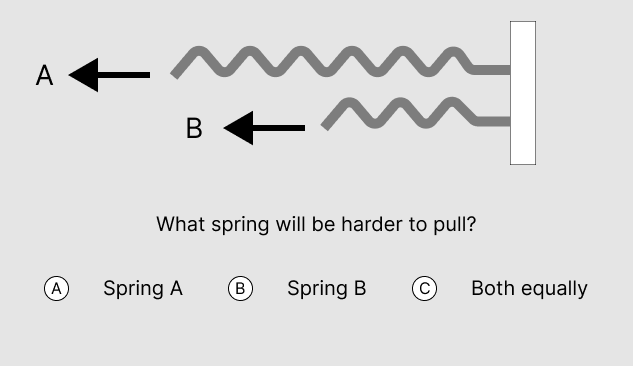
Answer and Explanation
The correct answer is B.
A spring’s stiffness is proportional to its length. The longer the spring, the less stiff it is. The underlying principle is Hooke’s Law.
Section 4 – Reasoning from Rules
Use the following passage for questions 13-15.
Data Protection Procedures
You are on duty as an overseer of a monitoring hub at a research facility. The procedure below describes the actions that should be taken in case of anomalies during experiments:
1. In case of an experiment malfunction of Data Overflow type, two separate scenarios must be considered:
1.1. If the malfunction is in Server A:
a. Alert the shift manager if the malfunction is in severity levels 1-3.
b. Alert the chief scientist if the malfunction is in severity levels 4 or 5.
1.2. If the malfunction is in Server B, alert the chief scientist.
1.3. All Data Overflow malfunctions of severity level 5 in are classified as acute danger for data loss (ADDL).
2. If an experimental malfunction is identified as GIGO type, carry out the following actions:
2.1. Perform a network speed evaluation.
a. If the result of the evaluation is less than 1.5 milliseconds, transmit a digital notification to the IT department.
b. If the result of the evaluation is higher than 1.5 milliseconds, contact the IT department directly to initiate immediate action. In addition, reboot the backup server.
3. However, in the case of an ADDL malfunction, additional measures should be taken:
a. The emergency backup plan should be set to standby mode for the first 10 minutes since the malfunction has been identified.
b. Activate the emergency backup plan after 10 minutes have passed.
Question 13
A Data Overflow malfunction in severity level 2 was identified in Server A. You should:
- Alert the chief scientist.
- Alert the shift manager.
- Alert the chief scientist and the shift manager.
- Perform a network speed evaluation.
Answer and Explanation
The correct answer is B.
According to rule 1.1.a., the shift manager should be alerted in the case of a Data Overflow malfunction in Server A if the severity level is 1-3.
Pro Tip
When preparing for you TECH test, try converting the long text into a summarized flowchart and see if it makes sense – some test-takers find it very helpful.
Question 14
A GIGO malfunction has been identified. You have carried out a network speed evaluation and the result is 2.4 milliseconds. You should:
- Transmit a digital notification to the IT department.
- Contact the IT department directly.
- Reboot the backup server.
- B and C.
Answer and Explanation
The correct answer is D.
According to rule 2.1.b., if the result of the network speed evaluation is higher than 1.5 milliseconds, you should contact the IT department directly AND reboot the backup server
Question 15
A Data Overflow error of severity level 3 was identified 12 minutes ago in Server B. You should:
- Alert the chief scientist.
- Alert the shift manager.
- Alert the chief scientist and activate the emergency backup plan.
- Alert the chief scientist and set the emergency backup plan to standby mode.
Answer and Explanation
The correct answer is A.
According to rule 1.2., in any case of a Data Overflow malfunction in Server B, the chief scientist needs to be notified. According to rule 1.3., the malfunction is not classified as ADDL as it is in severity level 3.

















